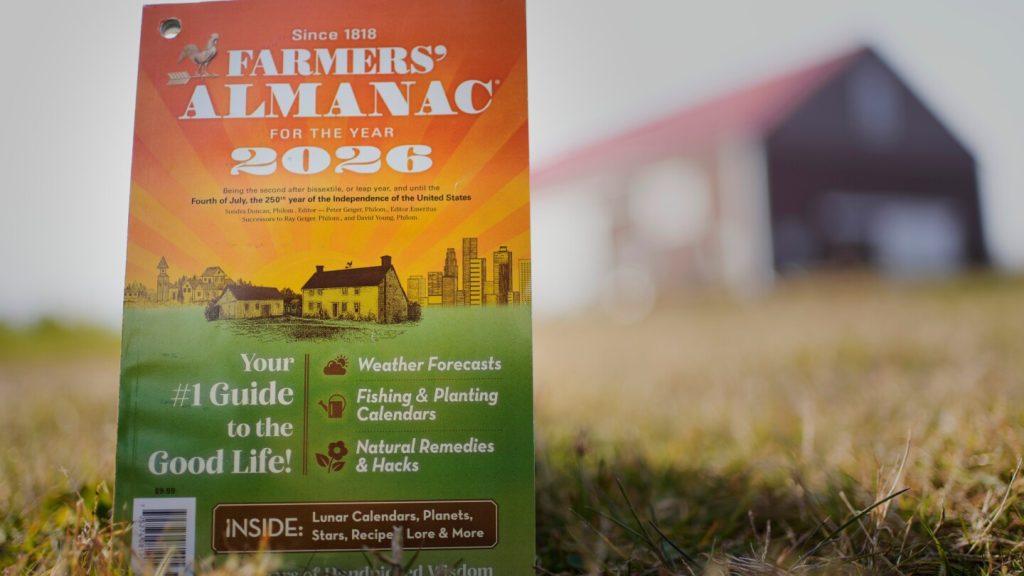Listen to the article
After 208 Years, Iconic Farmers’ Almanac Announces Final Edition
The Farmers’ Almanac, a centuries-old Maine-based publication that has guided generations of Americans with its weather predictions and planting advice, announced Thursday it will cease publication after its 2026 edition. The decision ends a remarkable 208-year run for one of America’s most enduring periodicals.
Citing the “chaotic media environment” and growing financial challenges of production and distribution, the publication will also terminate access to its online version next month. The announcement marks the end of a cultural institution that began in 1818.
“It is with a heavy heart that we share the end of what has not only been an annual tradition in millions of homes and hearths for hundreds of years, but also a way of life,” said Editor Sandi Duncan in a statement. She emphasized the almanac’s role in preserving “the wisdom of generations past” for future generations.
The closure has sparked confusion with its older competitor, The Old Farmer’s Almanac, which quickly clarified its status on social media: “The OLD Farmer’s Almanac isn’t going anywhere.” Based in neighboring New Hampshire and established in 1792, it’s believed to be North America’s oldest continuously published periodical.
Both almanacs emerged during an era when hundreds of similar publications served America’s predominantly agricultural society. Most were regional publications that disappeared as the nation industrialized. The Farmers’ Almanac, originally founded in New Jersey, relocated its headquarters to Lewiston, Maine, in 1955.
The two publications share similar content approaches, offering gardening tips, weather forecasts, trivia, jokes, and natural remedies. Both employ secret formulas based on sunspots, planetary positions, and lunar cycles to generate their long-range weather predictions – methods that have drawn skepticism from meteorologists and scientists.
Val Kiddings, senior fellow at the Information Technology and Innovation Foundation and a longtime researcher of science and agriculture, described the almanac as a “quaint relic” with a special charm, though its forecasting reliability was questionable. “It might have had some value looking back, as a historical indicator, but I never took any of its prognostications at all seriously,” Kiddings noted.
Studies examining the accuracy of the almanacs have found them to be slightly better than random chance, with accuracy rates just above 50 percent. Despite scientific criticism, the publications maintained devoted followings.
The news prompted an outpouring of nostalgia from readers who relied on the publication for generations. Julie Broomhall from San Diego told The Associated Press that she used the Farmers’ Almanac last year to plan a three-month cross-country trip, avoiding a major snowstorm in Oklahoma based on the almanac’s prediction. “I missed several I-40 mishaps because of the predictions,” she wrote.
In 2017, when the Farmers’ Almanac reported a North American circulation of 2.1 million, it was experiencing growth among urban readers interested in sustainable food sources and home gardening. This demographic shift prompted the publication to feature skyscrapers alongside the traditional farmhouse on its cover.
Throughout its history, the almanac offered a fascinating window into American cultural values. In 1923, it urged readers to maintain “old-fashioned neighborhoodliness” despite new technologies like cars and telephones. Earlier editions promoted health innovations, encouraging readers in 1834 to abandon tobacco and, in 1850, suggesting common bean leaves to combat bedbugs.
The almanac sometimes proved surprisingly progressive. An 1876 article advised women to develop independent skills rather than focusing solely on marriage, stating: “It is better to be a woman than a wife, and do not degrade your sex by making your whole existence turn on the pivot of matrimony.”
The Farmers’ Almanac’s closure represents the end of a publication that bridged America’s agricultural past with its modern present, surviving technological revolutions from the printing press to the internet before finally succumbing to the economic pressures of today’s digital media landscape.
Fact Checker
Verify the accuracy of this article using The Disinformation Commission analysis and real-time sources.




27 Comments
I like the balance sheet here—less leverage than peers.
Good point. Watching costs and grades closely.
Good point. Watching costs and grades closely.
I like the balance sheet here—less leverage than peers.
Good point. Watching costs and grades closely.
Interesting update on A lesser-known Farmers’ Almanac will fold after 2 centuries, citing money trouble. Curious how the grades will trend next quarter.
If AISC keeps dropping, this becomes investable for me.
Good point. Watching costs and grades closely.
Good point. Watching costs and grades closely.
Production mix shifting toward Business might help margins if metals stay firm.
Good point. Watching costs and grades closely.
If AISC keeps dropping, this becomes investable for me.
Exploration results look promising, but permitting will be the key risk.
Good point. Watching costs and grades closely.
Good point. Watching costs and grades closely.
I like the balance sheet here—less leverage than peers.
Good point. Watching costs and grades closely.
Good point. Watching costs and grades closely.
I like the balance sheet here—less leverage than peers.
Exploration results look promising, but permitting will be the key risk.
The cost guidance is better than expected. If they deliver, the stock could rerate.
Uranium names keep pushing higher—supply still tight into 2026.
Good point. Watching costs and grades closely.
Good point. Watching costs and grades closely.
Uranium names keep pushing higher—supply still tight into 2026.
Good point. Watching costs and grades closely.
Good point. Watching costs and grades closely.